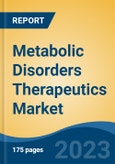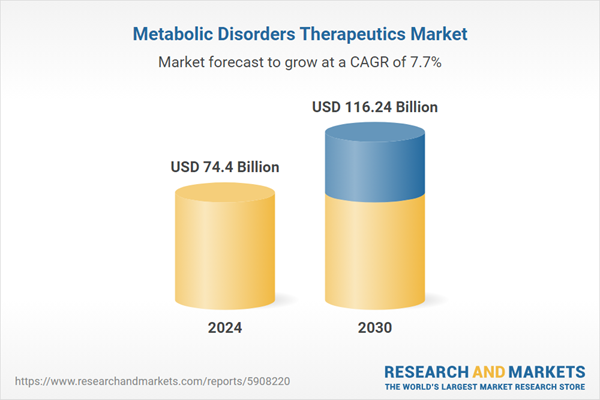Speak directly to the analyst to clarify any post sales queries you may have.
10% Free customizationThis report comes with 10% free customization, enabling you to add data that meets your specific business needs.
Market growth is being propelled by the rising global incidence of metabolic diseases, coupled with advancements in targeted therapies, including gene therapy, enzyme replacement therapy, and next-generation weight-loss medications. Leading pharmaceutical firms are investing heavily in R&D and strategic collaborations.
However, companies operating in this sector must address regulatory complexities, stringent clinical approval processes, and long-term safety concerns to maximize commercial potential. Firms that successfully integrate scientific innovation with regulatory compliance will be well-positioned to capitalize on the expanding demand for metabolic disorder therapeutics.
Key Market Drivers
Rising Prevalence of Metabolic Disorders
The increasing global burden of metabolic disorders is a primary force accelerating the growth of the Global Metabolic Disorders Therapeutics Market. As the incidence of diseases such as diabetes, obesity, hyperlipidemia, and rare genetic metabolic disorders rises sharply, the demand for innovative therapeutics, disease management solutions, and preventive interventions continues to grow. Several factors contribute to this trend, each reinforcing the market’s expansion and creating new opportunities for pharmaceutical and biotechnology companies.According to the IDF Diabetes Atlas (2021), 10.5% of the global adult population (ages 20-79) is living with diabetes, with nearly 50% of cases remaining undiagnosed due to limited awareness and screening gaps. Projections indicate that by 2045, the prevalence will rise to 1 in 8 adults, reaching approximately 783 million cases - a 46% increase driven by shifting demographics, urbanization, and lifestyle changes. Notably, over 90% of diabetes cases are classified as Type 2 diabetes, largely influenced by socioeconomic disparities, aging populations, environmental risk factors, and genetic predisposition. This surge in global disease burden is expected to intensify demand for advanced therapeutics, early diagnostic solutions, and digital health interventions, making diabetes management a critical priority for healthcare systems and pharmaceutical innovators.
Key Market Challenges
High Development Costs
The research and development of new therapies for metabolic disorders can be prohibitively expensive. The cost of conducting clinical trials, obtaining regulatory approvals, and ensuring safety and efficacy adds significant financial pressure to pharmaceutical and biotech companies.Key Market Trends
Precision Medicine and Personalized Therapies
The era of one-size-fits-all treatments is giving way to precision medicine. Genetic profiling, biomarker identification, and patient-specific data are increasingly guiding treatment decisions. Tailored therapies that consider an individual's genetic and metabolic profile promise higher efficacy and reduced side effects in the management of metabolic disorders.Key Market Players
- Novo Nordisk A/S
- Eli Lilly and Company
- Takeda Pharmaceutical Company Limited
- Sanofi SA
- Merck KGaA
- AstraZeneca PLC
- AbbVie Inc
- Johnson & Johnson Services, Inc
- Amgen Inc
- BioMarin International Limited
Report Scope:
In this report, the Global Metabolic Disorders Therapeutics Market has been segmented into the following categories, in addition to the industry trends which have also been detailed below:Metabolic Disorders Therapeutics Market, By Disease Type:
- Lysosomal Storage Diseases
- Diabetes
- Obesity
- Inherited Metabolic Disorders
- Hypercholesterolemia
- Others
Metabolic Disorders Therapeutics Market, By Therapy Type:
- Enzyme Replacement Therapy
- Cellular Transplantation
- Small Molecule Based Therapy
- Substrate Reduction Therapy
- Gene Therapy
- Drug Therapy
Metabolic Disorders Therapeutics Market, By Region:
- North America
- United States
- Canada
- Mexico
- Europe
- Germany
- United Kingdom
- France
- Italy
- Spain
- Asia-Pacific
- China
- Japan
- India
- Australia
- South Korea
- South America
- Brazil
- Argentina
- Colombia
- Middle East & Africa
- South Africa
- Saudi Arabia
- UAE
Competitive Landscape
Company Profiles: Detailed analysis of the major companies present in the Global Metabolic Disorders Therapeutics Market.Available Customizations:
With the given market data, the publisher offers customizations according to a company's specific needs. The following customization options are available for the report.Company Information
- Detailed analysis and profiling of additional market players (up to five).
This product will be delivered within 1-3 business days.
Table of Contents
Companies Mentioned
- Novo Nordisk A/S
- Eli Lilly and Company
- Takeda Pharmaceutical Company Limited
- Sanofi SA
- Merck KGaA
- AstraZeneca PLC
- AbbVie Inc
- Johnson & Johnson Services, Inc
- Amgen Inc
- BioMarin International Limited
Table Information
| Report Attribute | Details |
|---|---|
| No. of Pages | 186 |
| Published | March 2025 |
| Forecast Period | 2024 - 2030 |
| Estimated Market Value ( USD | $ 74.4 Billion |
| Forecasted Market Value ( USD | $ 116.24 Billion |
| Compound Annual Growth Rate | 7.6% |
| Regions Covered | Global |
| No. of Companies Mentioned | 10 |









